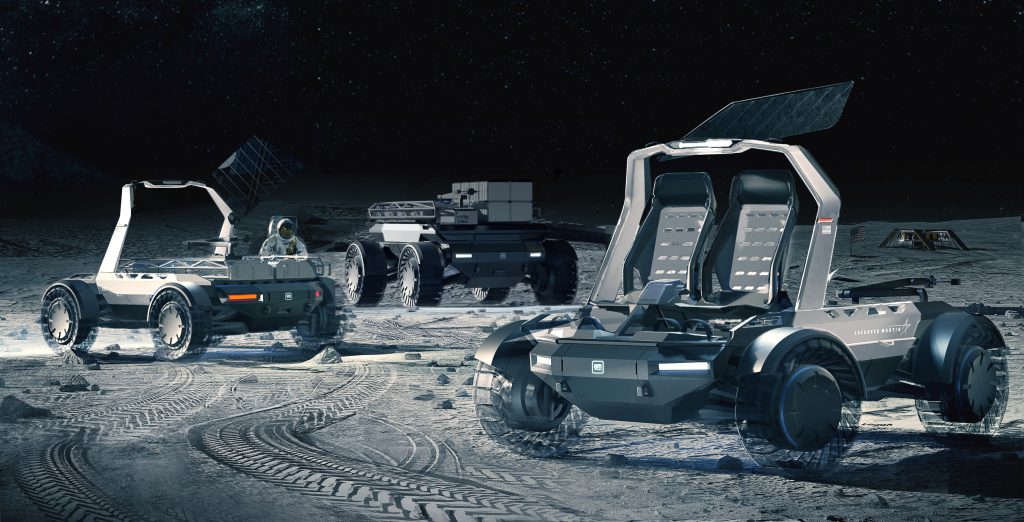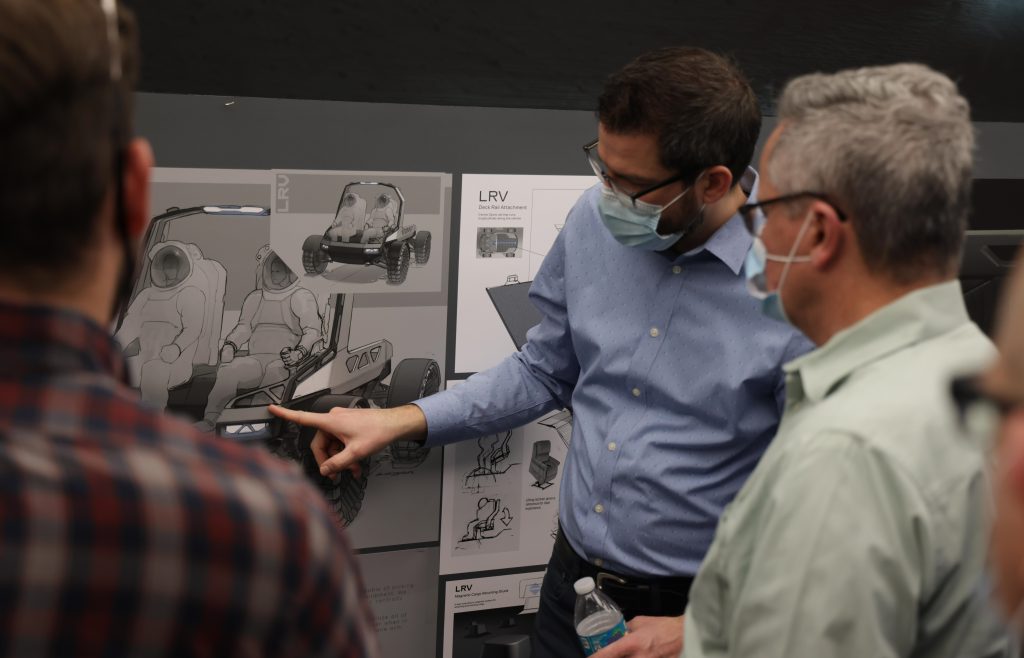Behind The Scenes of General Motors and Lockheed Martin’s Lunar Rover
A dive into the challenges of developing the moon vehicle of the future

General Motors designed the original lunar rover that was used during the Apollo space program of the early ’70s in partnership with Boeing. Now the Detroit-based carmaker hopes to return to the moon with a new rover—or Lunar Mobility Vehicle (LMV)—created in partnership with Lockheed Martin. Together, the two companies have designed a prototype in response to NASA’s call out for an LMV for the upcoming Artemis mission.

The next-generation moon vehicle has been designed to drive further and have a more powerful battery in order to take astronauts to the moon’s south pole, which has more difficult terrain and is colder and darker. It will also be an autonomous vehicle. Overall, the aim is to facilitate more comprehensive, longterm research on the moon. We visited the team’s design studio with Jeff Nield, Director of Product and Experience, Global Industrial Design at GM, who is at the helm on the lunar rover program, to find out more about the many differences—and similarities—of creating a vehicle for the moon.
How important has the partnership been with Lockheed Martin for this project?
Our two companies complement each other because we’re different, but we have the same mission. You’ve got Lockheed Martin, the number one human-rated space agency in the world, and you have General Motors, a leader in EV and AV—and the only company to have vehicles on the moon. It’s a perfect fit: the lunar rover is 50% aerospace and 50% transportation. We understand the chassis and the electrification and the AV, they understand the lunar environment and shipping something to the moon.
We’re privileged to be a part of this. We know how special it is. We know what’s on the line. And that really creates a great culture. The project is an obligation to humankind, so there’s this calming focus, I think, where everybody who’s involved in this project, they just want it to be the best it can be.
It still needs to be human-centric design
The moon and Earth are obviously very different places to drive, but can you tell us if there are similarities in the way you approach designing a vehicle for both?
The healthiest way to create anything in our industrial design space is to think about the environment and think about the target customer. We look at the environment and the customer, [in this case] it’s the moon and the astronauts, the Artemis mission, and we just started ideating. What’s different about this environment? And what’s different about the way that they’re oriented? On Earth, we control acceleration and [braking] with our with our foot. You can’t do that on the moon. Acceleration, braking and steering should happen by your hand. Do you want to place that somewhere central so that both astronauts can access the controls? Those are some things that were done in the original rover by General Motors that are still relevant today. It still needs to be human-centric design.

How is designing rovers for Artemis different than for Apollo?
NASA launched what they call an RFI (a request for information) and they opened it up to American companies to submit a response and they listed the criteria. Artemis is for longterm habitation on the moon, so it’s totally different than last time. For example, this rover has to live on the lunar surface and survive the night. That starts to change things. On the moon, it’s 250º F for 14 days and very bright. Then it’s dark for 14 days and it’s very cold [-298ºF], which is nuts! For our lunar rover to survive the lunar night, it has to be able to hibernate and basically go dormant and survive those conditions, and then light back up. Plus, there’s lunar dust: lunar regolith is electromagnetic and it sticks to the suits and all the equipment and it’s abrasive.
The way we’re approaching this is it’s really about problem-solving. It’s definitely not about styling. It’s about understanding the limitations of the spacesuit on the astronauts and the situation that they’re in up there. We have to think about the astronauts and their challenges. We’re designing outward from that, and everything that is based upon safety and simplicity—it’s intuitive. Fortunately, not only do we have a lot more technology at our fingertips, but the rover and the lander and the rockets are all being designed with each other in mind.
Another difference is that for Artemis, humans are brought in after the autonomous chapters. We deploy everything autonomously, we develop that infrastructure and then once things are all kind of set up seamlessly, then you have the astronauts. If there’s any R&D or nuancing that has to happen, we can do all that from here for a while.

It’s an open call and there are several companies vying for the project. How does that make the team feel?
It’s part of this pioneering journey that we’re on. It’s an exciting opportunity for anyone who’s in the mobility or transportation space. It’s motivating and keeps us hungry and humble, and we welcome all that with with open arms. At the end of the day, this isn’t about General Motors, it’s about the mission and supporting that mission and making sure that it’s as safe as possible. We acknowledge the significance of the Artemis mission—that’s the priority.
What kind of material innovation has happened in the last 50 years that is potentially interesting to work with?
I think the strength of carbon fiber is relevant. The previous rovers were predominantly aluminum, and we have titanium now, we have carbon fiber weave, we have forged carbon fiber. Even the way we paint, the colors we use will help with heat-reflection requirements.

This buggy is going to be mostly autonomous, tell us a little about that capability.
They’ll start autonomously, so the seats fold down and we want to smooth the deck and they’ll function like that for an extended period of time. Then once everything’s set up, it activates into a driven vehicle. It’s kind of interesting, it almost goes in reverse order: it doesn’t evolve into autonomy, it goes the other way. But then it’ll still have autonomous capability.
You’ve been sharing a lot of the development on a project one might think would be super-confidential. How has that been?
It’s different than anything that I’ve ever seen. We’ve been sharing our ideation with the public space in real time through social media. We’re co-developing and inviting input and feedback. I can’t recall a program that we’ve ever done like this. It’s wonderful because you actually can talk about it and get the input and bring it back. We’ve all been in this business for a while now, but this is super refreshing.
You know, if you’re an earthling, you’re probably familiar with that round thing in the sky at night. It’s part of everyone’s experience here. It’s this challenge that everyone can identify with and that transcends all cultures and all demographics.
Hero image courtesy of General Motors











